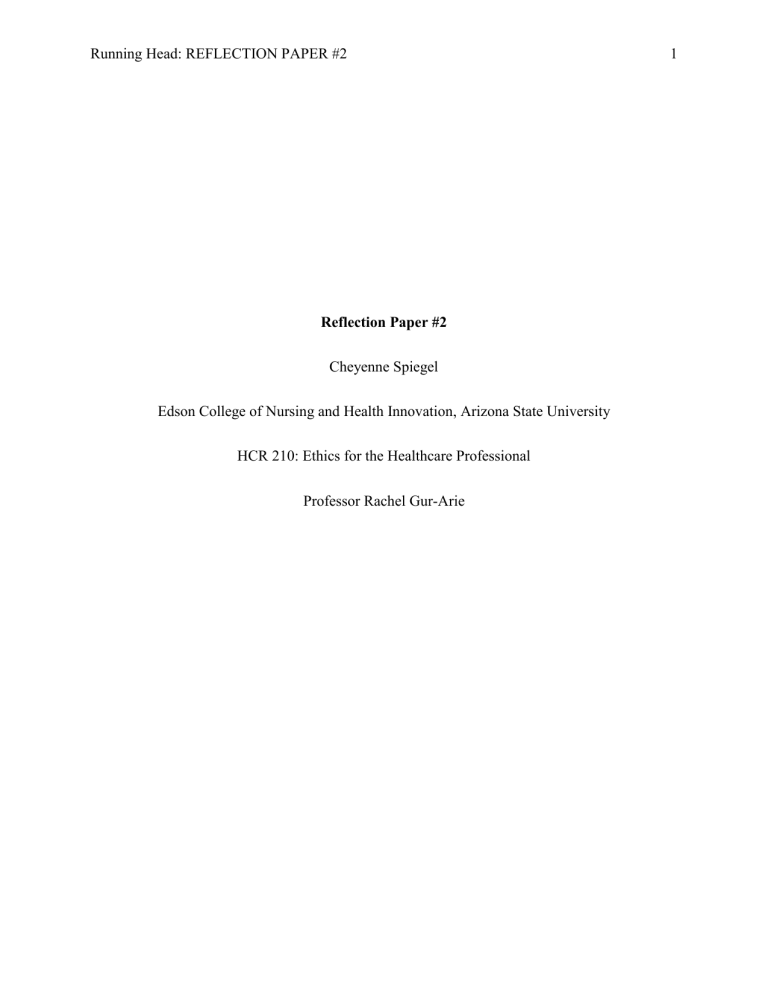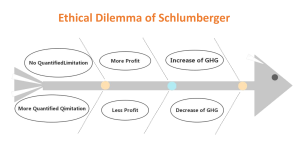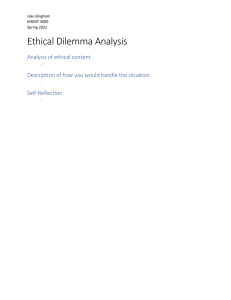
Running Head: REFLECTION PAPER #2 Reflection Paper #2 Cheyenne Spiegel Edson College of Nursing and Health Innovation, Arizona State University HCR 210: Ethics for the Healthcare Professional Professor Rachel Gur-Arie 1 REFLECTION PAPER #2 2 Ethical Dilemma There are many ethical dilemmas regarding the multitude of treatments for gender dysphoria. The first ethical dilemma presented in this case study is whether it is ethical to prescribe treatment (such as puberty blockers) to children who are not fully capable of making fully formed permanent decisions. The second ethical dilemma is whether a provider should treat an individual struggling mentally with gender dysphoria based on the concept of alleviating suffering despite professional or personal beliefs (Hayes, 2018, p.6). There are many more ethical dilemmas regarding gender dysphoria treatment, but based on my subjective opinion, the priority dilemma is the appropriateness of reviewing a patient’s suffering as a provider. Gender dysphoria is a condition in which an individual has a gap psychologically between their biological gender and their expressed or otherwise perceived gender (Hayes, 2018, p.2). The condition, while objectively a condition people suffer, is often debated amongst those with different subjective opinions and values. When making the decision on what option is best based on the ethical dilemma selected, the first part is to understand the objective facts. Objectively, some procedures are not reversible, such as mastectomy, hysterectomy, penectomy, or vaginoplasty; some treatments are reversible or at least not measurable permanent based on current data, such as puberty blockers (Hayes, 2018, p.9). Subjectively, some opinions make a permanent, irreversible decision on a youth’s body that is not acceptable or that the general statement of doing any means of intervention denies the person the “right” to potentially “outgrow” that feeling or decision. The moral agents involved are the patient, the doctor, anyone involved in the research, propelling or halting gender dysphoria treatment, and the general public by default due to external forces. The external forces REFLECTION PAPER #2 3 on this topic include political and potentially legal based on potential repercussions, social/cultural, and religious/spiritual. Ethical Theories & Principles Depending on the argument and belief system, the individual reviewing the ethical dilemma would use different theories to back their perspective. If a person is involved in natural law theory, they would advocate against the change of a “God-given” assignment of gender, and it would be violating the right of that assignment. If a consequentialist were applied to this case, they would argue that it’s about the maximum good to the situation. That would, of course, depend on the number of individuals for or against the change. If the patient, their family, and the provider agreed it was the best decision, then it would be right to do the procedures/therapy. If the majority did not agree it was for the best, solely the patient, it would not be right based on the consequences. A deontologist would argue that it’s a sense of duty to another to do right by them based on what the individual believed would make a better world. The answer to a deontologist would be about the reason behind the action, which would be to help the person suffering, not to be suffering (Morrison & Furlong, 2019, p. 5). The ethical principles involved are beneficence, non-maleficence, and autonomy. Beneficence is not just about avoiding harming someone but about doing good to help others. It could be argued that the provider is obligated to help the individual as it will help them not be mentally in a state of suffering and would create a sense of peace and mental happiness for them (Morrison & Furlong, 2019, p. 43). Non-maleficence is the idea that there would be no harm done and that there is no debate but not to harm them (Morrison & Furlong, 2019, p. 41). However, this could be subjective to the fact that one could feel doing permanent therapy or surgery would harm the patient in treatment or the opposite, as stated above, alongside REFLECTION PAPER #2 4 beneficence. The other principle is autonomy because that’s the patient’s right to choose what they want in their treatment because it is their bodily right, and to that, it would be for treating the individual (Morrison & Furlong, 2019, p. 44). Addressing Ethical Issues and Personal Ethical Alignment In my opinion, the possible solutions are to either address the patient’s concern with their desired need to be treated or not to treat the patient. It’s not a multiple-option situation because everyone will have their own opinion, but the result is either to treat or not. While I personally would not advocate for someone under the age of eighteen to make a long-lasting decision such as surgery or puberty blockers (which have some sort of permanence to development), it’s not fair as a provider to decide that based on the bias one already must not treat a patient that’s in mental suffering and pain. I would treat the patient because it’s my job to treat them, not to give them my opinion on their life choices. I follow a deontological point of view that I would want to live in a world where I had the choice of how to live. My reflection on this issue, therefore, is that because I answered my opinion on this case but still went the opposite of that in my choice to serve the patient, it shows that they don’t always have to align. REFLECTION PAPER #2 5 References Hayes, K. (2018). Ethical implications of treatment for gender dysphoria in youth. Online Journal of Health Ethics, 14(2). http://dx.doi.org/10.18785/ojhe.1402.03 Morrison, E. E. & Furlong, B. (2019). Health care ethics: Critical issues for the 21st century (4th ed.). Jones & Bartlett Learning.


